In the rapidly evolving world of telecommunications, each generation of wireless technology brings forth transformative changes. From the first generation (1G) that introduced mobile voice calls to the fifth generation (5G) enabling lightning-fast data speeds, the progression has been remarkable. Now, the world eagerly anticipates the arrival of the next leap forward – 6G.
Introduction
As the successor to 5G, 6G represents the next evolution in wireless communication technology. While still in its conceptual stages, researchers and industry experts are already envisioning the possibilities it could unlock. Unlike its predecessors, 6G aims to not only enhance connectivity but also revolutionize various aspects of daily life.
Evolution from 5G to 6G
The limitations of 5G
While 5G offers significant improvements over its predecessors in terms of speed and latency, but it still has its limitations. Well, coverage in rural areas, signal penetration through buildings, and latency issues are some of the challenges that continue with 5G technology.
The promise of 6G
6G promises to address these limitations and push the boundaries even further. With speeds projected to be several times faster than 5G and latency reduced to mere microseconds, it opens doors to applications that were previously unthinkable.
Key Features
6G, the next generation of wireless technology, is expected to introduce groundbreaking features that will redefine connectivity and communication. While we are still in the early stages of development, experts predict a few key features that could distinguish 6G from its predecessors.
Ultra-Fast Speeds:
It is expected to deliver unprecedented data speeds, potentially reaching terabits per second. This would enable lightning-fast downloads, seamless streaming of high-definition content, and real-time communication with minimal lag.
Ultra-Low Latency:
Reducing latency to microseconds or even nanoseconds, 6G aims to enable instantaneous communication and response times. This ultra-low latency is crucial for applications such as remote surgery, autonomous vehicles, and immersive gaming experiences.
Massive Connectivity:
Moreover, it is projected to support a huge number of connected devices simultaneously, creating a dense network of interconnected devices. This capability will facilitate the Internet of Things (IoT), smart city initiatives, and seamless integration of various technologies.
Energy Efficiency:
Efforts are underway to make 6G networks more energy-efficient and sustainable. By optimizing transmission protocols, minimizing power consumption, and leveraging renewable energy sources, 6G aims to reduce its environmental footprint while prolonging battery life in devices.
Advanced Technologies:
Terahertz waves, quantum computing, and other cutting-edge technologies are expected to play a significant role in 6G networks. These technologies will provide higher bandwidth, enhanced security, and greater reliability, enabling innovative applications across industries.
Intelligent Networks:
6G networks will be equipped with artificial intelligence (AI) and machine learning algorithms to optimize performance, predict user behavior, and adapt to changing network conditions in real-time. This intelligence will enable dynamic resource allocation and network management.
Security and Privacy:
Addressing concerns about security and privacy, 6G aims to implement robust encryption mechanisms, authentication protocols, and privacy-preserving technologies. Protecting sensitive data and ensuring the integrity of communication networks will be paramount in the 6G era.
Global Coverage:
6G endeavors to provide seamless coverage worldwide, including remote and underserved areas. By leveraging satellite communications, aerial platforms, and ground-based infrastructure, 6G aims to bridge the digital divide and promote digital inclusion on a global scale.
Technologies Enabling 6G
Terahertz waves
Terahertz waves, with frequencies higher than those used in current wireless technologies, are at the forefront of 6G research. These waves offer unprecedented bandwidth and the potential for ultra-fast data transmission.
AI integration
Artificial intelligence (AI) will play a significant role in optimizing 6G networks. From network management to resource allocation, AI algorithms will continuously adapt to changing conditions, ensuring optimal performance.
Quantum computing
Quantum computing holds the promise of solving complex problems beyond the capabilities of classical computers. In the context of 6G, it could revolutionize encryption methods, ensuring secure communication in an increasingly interconnected world.

Applications of 6G
Augmented reality (AR) and virtual reality (VR)
6G will unlock new possibilities for immersive experiences, enabling seamless AR and VR applications. From virtual meetings to interactive gaming, the boundaries between the physical and digital worlds will blur.
Internet of Things (IoT)
The proliferation of connected devices will accelerate with 6G, leading to smarter homes, efficient transportation systems, and enhanced healthcare solutions. From smart appliances to wearable devices, the IoT ecosystem will thrive on reliable 6G connectivity.
Autonomous vehicles
6G’s low latency and high reliability are essential for the widespread adoption of autonomous vehicles. From enhanced navigation systems to vehicle-to-vehicle communication, it will pave the way for safer and more efficient transportation networks.
Healthcare
In the healthcare sector, 6G will enable remote patient monitoring, telemedicine consultations, and advanced medical imaging techniques. Access to real-time data and high-resolution imagery will revolutionize diagnosis and treatment options.
Challenges and Concerns
While 6G holds immense promise for revolutionizing wireless communication, it also presents several challenges and concerns that need to be addressed:
Security:
With increased connectivity and reliance on digital networks, 6G systems may become vulnerable to cyberattacks, data breaches, and unauthorized access. Ensuring robust security measures, encryption protocols, and authentication mechanisms will be essential to safeguarding sensitive information and protecting user privacy.
Privacy:
As 6G enables the collection and processing of vast amounts of data from connected devices, concerns about user privacy and data protection will escalate. Striking a balance between data collection for legitimate purposes and respecting individuals’ privacy rights will be crucial to building trust and maintaining user confidence in 6G networks.
Environmental Impact:
The deployment of 6G infrastructure, including antennas, base stations, and network equipment, may have significant environmental implications. Addressing concerns related to energy consumption, electronic waste management, and electromagnetic radiation exposure will be imperative to minimizing the environmental footprint of 6G technology.
Regulatory Frameworks:
The development and deployment of 6G networks will require robust regulatory frameworks that ensure compliance with legal and ethical standards. Regulatory bodies will need to establish guidelines for spectrum allocation, network deployment, data governance, and consumer protection to promote fair competition, innovation, and responsible use of 6G technology.
Digital Inclusion:
Bridging the digital divide and ensuring equitable access to 6G technology will be critical to preventing socioeconomic disparities and promoting digital inclusion. Efforts to expand network coverage, reduce infrastructure costs, and provide affordable devices and services will be essential to ensuring that everyone can benefit from the opportunities offered by 6G.
| Call 866-861-4084 for Internet Deals |
What will 6G look like?
What will 6G look like? This question sparks curiosity and anticipation as the world awaits the next evolution in wireless communication technology. While we can’t predict every detail with certainty, we can paint a picture based on current trends and emerging technologies.
First and foremost, it will be characterized by unprecedented speed and efficiency. Data rates are expected to soar to unimaginable heights, potentially reaching terabits per second. This means that tasks that currently take minutes or even hours to complete will be accomplished in mere seconds.
Moreover, 6G will boast ultra-low latency, virtually eliminating delays in communication. Whether you’re streaming live video, gaming in real-time, or controlling autonomous vehicles, the responsiveness of 6G networks will be instantaneous. This low latency will be crucial for applications that require split-second decision-making, such as remote surgery or industrial automation.
In terms of connectivity, it will usher in an era of ubiquitous coverage. No longer will you have to worry about dropped calls or buffering videos. Whether you’re in a bustling city or a remote rural area, reliable 6G connectivity will be available everywhere.
But 6G is not just about speed and coverage; it’s also about intelligence. Artificial intelligence (AI) will play a central role in optimizing 6G networks, constantly analyzing data, and adapting to changing conditions. This intelligence will enable dynamic resource allocation, ensuring that network resources are allocated efficiently and effectively.
In terms of devices, 6G will support a wide range of connected devices, from smartphones and tablets to IoT devices and autonomous vehicles. These devices will seamlessly communicate with each other, forming a cohesive network of interconnected smart devices.
4G vs. 5G vs. 6G
The evolution of wireless technology has been a remarkable journey, marked by successive generations that have brought about significant advancements in connectivity, speed, and capabilities. From the introduction of 1G in the 1980s to the latest developments in 5G, and the anticipation surrounding the future of 6G, each generation has built upon the foundation laid by its predecessors.
1. 4G (Fourth Generation)
Introduction: 4G, also known as LTE (Long-Term Evolution), represented a significant leap forward from its predecessors in terms of data speed and capacity.
Features:
Speed: 4G offered download speeds of up to 100 Mbps, significantly faster than previous generations.
Low Latency: Reduced latency enabled smoother streaming, gaming, and real-time communication.
Advanced Services: Enabled high-definition video streaming, video conferencing, and mobile gaming on a large scale.
Widespread Adoption: 4G became the dominant mobile technology worldwide, supporting a wide range of devices and applications.
2. 5G (Fifth Generation)
Introduction: 5G represents the current state-of-the-art in wireless technology, promising even faster speeds, lower latency, and enhanced connectivity.
Features:
Speed: 5G offers download speeds up to 10 Gbps, making it significantly faster than 4G.
Ultra-Low Latency: Reduced latency to milliseconds enables real-time applications such as remote surgery and autonomous vehicles.
Massive Connectivity: Supports a vast number of devices simultaneously, facilitating the Internet of Things (IoT) and smart city initiatives.
Advanced Technologies: Utilizes technologies like millimeter waves, massive MIMO (Multiple Input, Multiple Output), and network slicing for optimal performance.
Applications: Enables transformative applications such as augmented reality (AR), virtual reality (VR), and edge computing.
3. 6G (Sixth Generation) – The Future of Wireless Technology
Expected Features:
Speed: Projected to offer speeds beyond 5G, potentially reaching terabits per second.
Ultra-Low Latency: Aimed at reducing latency to microseconds or even nanoseconds, enabling instantaneous communication.
Intelligent Networks: Leveraging artificial intelligence and machine learning for dynamic network optimization and resource allocation.
Advanced Technologies: Expected to utilize terahertz waves, quantum computing, and other cutting-edge technologies for enhanced performance.
Ubiquitous Connectivity: Providing seamless coverage even in remote areas and underground environments.
Transformative Applications: Enabling revolutionary applications across industries, from healthcare and transportation to entertainment and education.

What do experts say about 6G?
The anticipation surrounding 6G, the next generation of wireless technology, has sparked considerable interest and speculation among experts in the field. While 6G is still in the early stages of development, experts from various disciplines have offered insights into its potential features, applications, and implications.
1. Ultra-Fast Speeds and Low Latency
Experts foresee that 6G will offer unprecedented speeds and ultra-low latency, significantly surpassing the capabilities of 5G. Some projections suggest that 6G could achieve data rates exceeding terabits per second, enabling near-instantaneous downloads and real-time communication with latency reduced to microseconds or even nanoseconds.
2. Massive Connectivity and Intelligent Networks
6G is expected to support a vast array of connected devices, from smartphones and IoT sensors to autonomous vehicles and smart infrastructure. Experts envision intelligent networks that leverage artificial intelligence and machine learning algorithms to optimize performance, allocate resources efficiently, and adapt dynamically to changing conditions.
3. Advanced Technologies and Applications
Terahertz waves, quantum computing, and other cutting-edge technologies are likely to play a pivotal role in realizing the full potential of 6G. Experts anticipate transformative applications across various industries, including healthcare, transportation, manufacturing, entertainment, and beyond. These applications may include augmented reality (AR), virtual reality (VR), holographic communication, remote surgery, autonomous systems, and immersive gaming experiences.
4. Socioeconomic Implications and Challenges
While the possibilities of 6G are exciting, experts also acknowledge the need to address potential challenges and implications. These may include concerns related to security, privacy, environmental sustainability, regulatory frameworks, digital inclusion, and socioeconomic disparities. It will be crucial to ensure that 6G technology is deployed ethically, responsibly, and inclusively to maximize its benefits for society as a whole.
| Call 866-861-4084 for Internet Deals |
Conclusion
In conclusion, 6G represents a paradigm shift in wireless communication technology, promising ultra-fast speeds, ultra-low latency, and massive connectivity. While the full extent of its impact remains to be seen, one thing is certain – 6G will shape the future in ways we can only imagine.
FAQs
What is the timeline for the rollout of 6G?
The exact timeline for the rollout of 6G is still uncertain. While some experts predict commercial deployment by the late 2020s or early 2030s, others believe it could take longer due to technological challenges and regulatory considerations.
How will 6G affect existing industries?
6G has the potential to revolutionize existing industries by enabling advanced automation, improving efficiency, and unlocking new business models. From manufacturing and healthcare to transportation and entertainment, every sector will experience significant transformation.
What role will governments play in the development of 6G?
Governments worldwide are investing heavily in research and development to ensure their countries remain at the forefront of 6G innovation. Collaboration between governments, industry stakeholders, and academic institutions will be crucial for driving progress and setting regulatory standards.
Will 6G pose health risks due to increased radiation exposure?
While concerns about radiation exposure from wireless technologies exist, extensive research is ongoing to ensure the safety of 6G networks. Regulatory bodies such as the World Health Organization (WHO) and national health agencies will continue to monitor and assess potential health risks associated with 6G.

Meet Jennifer Harper, a wordsmith extraordinaire who has been shaping the digital landscape with her creative prowess for the past two years. Not just a content writer; she is a storyteller who brings the content to life. Her passion for internet trends, memes, and the ever-evolving world of entertainment is evident in every piece she creates. Jennifer doesn’t just follow trends; she sets them.